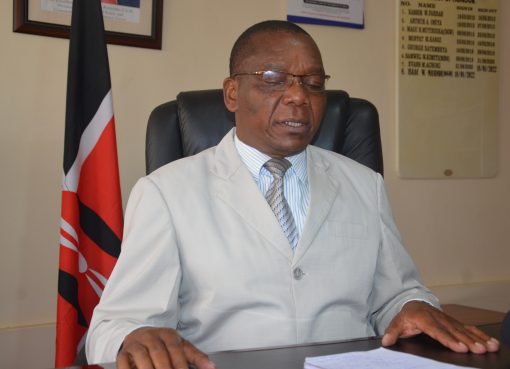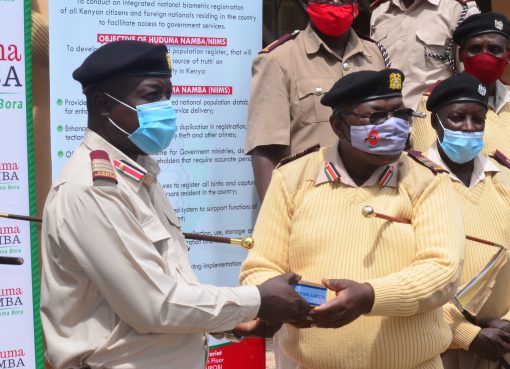Central Region Commissioner Fredrick Shisia has blamed the slow pace in realizing 100 percent success in the fight against illicit brews and substance abuse on leadership wrangles and inadequate resources to support the campaign.
Speaking in Nyeri County on Wednesday during the handing over ceremony of the accreditation certificate to the Ihururu Rehabilitation and Treatment Centre in Tetu, Shisia noted that whereas the other four counties of Kiambu, Kirinyaga, Nyeri, and Nyandarua had made headways in the fight against drugs and consumption of killer brews, the ongoing leadership wrangles and the lack of collaboration between the leaders in Murang’a county was dragging the region behind.
The Region boss nevertheless reiterated the Government’s resolve in intensifying the war against alcoholism and drug abuse in the area which has borne the brunt of the vice over the years.
“As a region, we have so far managed to achieve about 75 percent success in this war against drug abuse and illicit brews although we have a challenge in some counties. I would particularly like to speak about Murang’a County where we have a challenge of cooperation but we are still engaging leaders in the county as we try to look for a solution,” said the Regional Commissioner.
The administrator likewise attributed the slow pace of reforms to the lack of resources to support the fight against illicit brews and drugs.
He said that whereas the region had adopted a four-pronged strategy in fighting the vice, the big resource gap was still an impediment to achieving a speedy breakthrough.
“The first approach was sensitization, the second was enforcement, the third was rehabilitation and the fourth was aftercare. We have made headways in sensitization although there is a big resource challenge, we haven’t been able to cover much ground. We also have challenges in enforcement and rehabilitation due to a lack of adequate resources. In aftercare, we are also having challenges and we want to ask for more officers who will establish outreach programs to follow up on the recovered addicts,” said Shisia.
On his Interior Cabinet Secretary Professor Kithure Kindiki who was the chief guest during the event said the Government was in the process of introducing a new legislation to enable the National Authority for the Campaign Against Drug and Alcohol Abuse (NACADA) to repress the illicit alcohol and drug supply chain.
Under the new legislation, NACADA will for the first time, have powers to deal with the manufacturers and suppliers of the killer brews together with those involved in the distribution of drugs at source.
Currently, the authority’s sole mandate is limited to undertaking public education and awareness campaigns against alcohol and drug abuse in schools, workplaces, colleges, universities, technical institutions, county governments, ministries, parastatals, national government administrative offices, faith-based institutions, Community Based Organizations, Non-governmental Organisations.
“We have brought legislation to strengthen the powers of NACADA to make sure we empower NACADA to not only suppress the demand for drugs and alcohol but also to increasingly suppress the supply chain. And therefore, we want to destroy the manufacture and supply chain of alcohol and drugs as much as we are dealing with the demand for them. That legislation will go a long way in strengthening the fight against drug and alcohol abuse,” said the CS who also promised a Sh. 5 million donation to the facility to enable it to purchase crucial facilities like water tanks.
The 90-bed capacity facility opened its doors in September this year after an assessment by NACADA to ensure that it met all the set requirements to offer treatment for addiction.
The center is the only public facility in the county that offers treatment for drug and alcohol addiction. Currently, a total of 14 patients are admitted to the facility.
A report released by the National Authority for the Campaign Against Alcohol and Drug Abuse (NACADA) in mid-May revealed that alcohol was found to be the most abused drug in the country with 3,199,119 of the population affected, followed by Tobacco and Khat at 2,305,929 and 964,737 affected people respectively.
According to the findings, the Western region leads in the use of change at 11.4 percent followed by Nyanza at 6.3 percent and Rift Valley at 3.6 percent. The Central region on the other hand has the highest prevalence of portable spirits at 4.1 percent followed by Coast at 3.2 percent and Rift Valley at 3.1 percent.
Whereas Western Kenya is leading in illicit brewing consumption followed by Nyanza then Rift Valley, the Mt Kenya region suffers from a high prevalence of portable spirits with high poison levels, according to NACADA findings
In April this year, Deputy President Rigathi Gachagua announced that he would spearhead the war against illicit brews and drugs after it emerged that the Central region had the highest level of illicit alcohol consumption.
A recent report released by NACADA shows that the Central region recorded the highest number of people consuming portable spirits at 4.1 percent against the national average of 2.5 percent.
The Coast region was ranked second with 3.2 percent while Rift Valley recorded the third highest number of people consuming second-generation liquor at 3.1 percent.
According to the report, the respondents noted that the production and consumption of illicit brews including chang’aa had increased.
Further, they equally noted an increase in the number of bars in their community in the last five years with the Central region recording the highest perception level followed by Nairobi and Eastern.
By Samuel Maina and Wangari Mwangi




